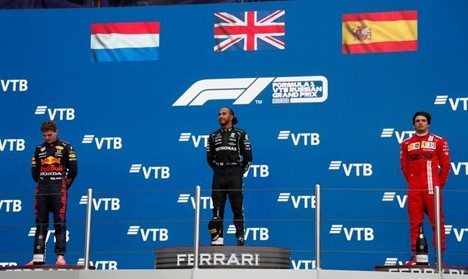In such an ultra-competitive sport as Formula 1 racing, every win matters. Much prestige is on offer (not to mention financial rewards) with the title, therefore the right mixture of art (driver’s performance) and science (everything else but the driver…) must be perfectly and precisely executed to earn the world championship title.
The challenging context
The Sochi Formula 1 circuit located in a Black Sea resort, is the first purpose-built Formula One facility in Russia. Located within Sochi’s impressive Olympic Park facility, the 5.848-kilometre circuit provides a fresh challenge to teams and drivers alike.
September 26th, 2021, round 15th (of a total of 22 rounds) is about to be launched and the Mercedes-AMG Petronas team who were the leaders, had to deal with two major challenges: Firstly their leading driver and F1 world champion, Lewis Hamilton wasn’t able to earn Pole Position and was about to start the race from 4th place. Then, their second driver suffered a series of technical issues which forced him to start the race from 16th place (out of 20 cars).
Following the qualifying laps, a young driver Lando Norris, who was competing for the McLaren team had scored a sensational first pole for the race.
Each driver had their own target – Lewis wanted his elusive 100th win and Lando wanted his first.
As soon as the lights went off and the race began, Norris was in the leading position while Lewis Hamilton fell to seventh place. However, his pace was competitive and at lap 38 (out of 53 laps) it was Norris leading a rapid Hamilton.
With eight laps remaining, the pair were just one second apart. Norris was riding for his first ever win, while Hamilton wanted the title lead. The pressure was on for both drivers.
The unexpected curveball
And then the weather changed, and the rain hit…
This was a surprising and unplanned situation. Both drivers and their supporting racing teams had to quickly evaluate the new conditions and react strategically, it was clear the drivers had to return to their pit-stop and replace their tyres to a fresh set – more suited to the wet weather that would provide them the needed grip. With minute-by-minute updates between both drivers and their teams on performance, position and weather, decision-making was key – not just the decision on changing the tyres but the pivotal moment when to do it.
Here is where it becomes a fascinating interplay between the pit-lane team and the drivers. Ultimately, it is the drivers who make the vital decision but it is the team behind them letting them know what is happening on a wider level – whether it is the rain forecast on the next turn or how the other competitors are performing.
You begin to see the art and science work together and sometimes not! So how did the two drivers and their decisions affect the outcome?
What makes a winning combination?
As the rainfall increasingly slickened the track, Hamilton first ignored his team’s call to come in and change his tyres to intermediate (Box, box, box!) as he could see what was immediately in front of him and thought he could keep going as the rain was slowing (or so he thought) …
Listening to the radio, it was almost like a negotiation between the team players…
However following analysis with more rain forecast, Hamilton’s team encouraged the driver to reconsider and to stop for a tyre change (“Pit Confirm!”). This was a subtle difference where up to that point the team were allowing Hamilton space to consider, but here it felt like a decision was made on his behalf rather than a request. This became a vital decision as he flew after Norris with his now greater grip on the intermediate tyres.
And can you imagine the pressure on the mechanics in the pitlane to do that tyre change as well as their experience and skills would ever do?!
His younger compatriot, who had stayed out and taken his own decision in the heat of battle, not wanting to let go of his leading position, then slid off the increasingly slippery Sochi surface.
This allowed Hamilton to cruise beyond him and secure a victory while denying Norris’s chance to seal his own maiden victory in F1.
What was evolving as a chaotic situation, almost impossible to overcome and control; became a huge success for Hamilton and his racing team – earning them a history-making achievement as Hamilton became the first F1 driver ever to reach 100 wins.
What were my key takeaways from this amazing race?
In many ways, the business world and a racing team share a lot of common themes with each other: while the CEO (or the driver) is the one who is leading the team and needs to make decisions to help his organization (team) flourish, he should also be a talented communicator who must share his analysis and assessment about the state of the business but also allow his team members to feed him with trustworthy and timely data/metrics so that he can make the right decisions (while also having the right to ignore/deprioritize data that is not critical).
A key factor to consider is that it’s not only about what data is being fed by the team but also when (the context) so that a decision-making process may generate different decisions (sometimes even contradicting) simply because the context changed.
From a broader perspective, an organization, much like a racing team, is a group of people working together towards a common mission and each member of the team is crucial in the process. It is also up to the CEO (driver) to celebrate success and acknowledge the contribution of the members in achieving the goal (listen how Hamilton reflects on the race and thanks the whole team at the end of the race). It’s also important to keep in mind that using proven equipment (those intermediates!) and perfecting a process makes a difference in both worlds to support a winning strategy.
My final thought is that in today’s business world, much like in professional racing, the fact that one may be in the lead and positioned to win the race, should not prevent him/herself from continuously challenging and assessing the situation, be open to making rapid changes, and adapting to the environment to make sure the other players won’t take advantage of these changes to gain the lead and win the race…
Speak to Prodware about Business Transformation to support your race to succeed.
Originally posted on LinkedIn.






